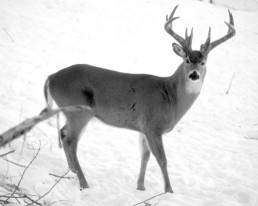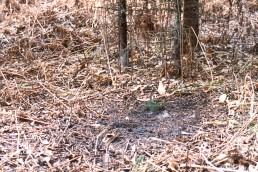Buck Witchcraft
SHARE THIS POST
My first hint about why older white-tailed bucks are so skilled at keeping out of sight of hunters came to light one day in 1954. It was the day another student in the basement of the Psychology building at the University of Minnesota, who was also using white rats to study animal behavior, said, “Your rats never fail to become really excited in their cages about fifteen minutes before you arrive.” Whereas this seemed somewhat logical because I was the only person who fed them, it was nonetheless strange that they could sense when I was headed their way while still a block or more away.
Was this attributable some kind of animal witchcraft, or a combination of past events that my rats had become accustomed to that added up to, “Oh boy, we’re soon going to get something to eat?” Maybe it was something simple, such as a certain number of gongs on a clock on the second floor that we humans couldn’t hear that triggered this behavior.
I probably would have forgotten about this altogether if some older bucks in my Aitkin County study area had not been doing something similar: disappearing for a couple of weeks or so beginning a few days before the firearm hunting season began, and then reappearing a few days after it ended. Years later, three farmers, one in South Dakota, one in Minnesota and one in Wisconsin, sent me photos of huge bucks that regularly fed in their yards and then did the same thing, so this was not unique whitetail behavior in one small area.
Some older bucks in my study area disappeared by becoming nocturnal (active during nighttime hours only) and/or temporarily abandoning their ranges, which older bucks are inclined to do during a hunting season when alarmed enough by hunters to raise their tails and flee with all-possible speed. Some other older bucks my sons and I came to know well, all 4 1/2- to 6 1/2-year-old dominant breeding bucks, remained in their square-mile home/breeding ranges throughout our early November hunting seasons when does were in heat, continuing to live fairly normal lives, even though one or another of us was stand hunting in their ranges. Most years, we took one of these bucks, and sometimes two (three one year).
A few of the bigger bucks that remained in their ranges during hunting seasons were very different, notably being the most difficult or impossible to hunt of bucks we had have ever known—even though we discovered their fresh identifying tracks in snow daily, and thereafter stand hunted near wherever they were currently active (using our backpacked stools to sit on). These bucks seemed to enjoy evading us. Some even taunted us by providing evidence that made it plain they knew exactly what we were doing: Like making fresh tracks on top of our tracks on trails we used minutes or hours earlier, or making tracks next to our stand sites while we were eating lunch back in camp. One even made a new antler rub on the tree trunk I leaned against while seated on my stool the previous afternoon and evening.
Most frustrating were discoveries of their recently used beds in snow where they could keep an eye on us at our stand sites without being seen; or worse, by making their fresh tracks in snow on top of our tracks within thirty yards downwind of our tree stands or ground level blinds, where they stood to observe us while we were staring in the opposite direction, after which they walked away unalarmed and undiscovered. After we began changing stand sites daily, and then twice daily to make it more difficult for them to avoid us, some even began searching for our stand sites or downwind-spreading airborne scents early each morning, before beginning their own intended activities. Bucks that did such things often finally convinced us to quit wasting time and hunt other bucks.
The question is, is keeping out of sight of hunters by any using any of the above means a matter of extraordinary luck for a buck? Or are some or all older whitetails, especially big bucks, imbued with an unusual sixth sense that enables them to routinely find and safely avoid us, not uncommonly without our knowledge?
Where I hunt deer today, numerous monumental preludes to deer hunting begin in mid-August with the sudden invasion of noisy ATVs ridden by black bear hunters preparing stand sites and hauling in bait. Two weeks later, deer in this region begin hearing the familiar blasts of high-powered rifles being fired at bears. Another two weeks later, they begin hearing shotguns being fired at ruffed grouse from endless numbers of ATVs roaring past on backwoods trails. Still another two weeks later, duck hunting begins.
After all this, we begin our own thorough invasions on foot, scouting, selecting stand sites, marking approach trails with fluorescent tacks, and finally setting up our deer camp, made obvious by sounds of multiple vehicles, and multiple human voices, setting up multiple tents, followed by a couple of days of cutting and chopping firewood. No great intellect is then needed by well-experienced whitetails to realize it’s time to begin doing what they did during previous hunting seasons to keep out of sight of us.
Are you enjoying this post?
You can be among the first to get the latest info on where to go, what to use and how to use it!
There’s nothing mysterious about that, but when older bucks we know well began regularly avoiding us while using new hunting tactics that worked very well during the previous hunting season or two, that is mysterious. It proves our older bucks are quick learners and have excellent memories. It proves they are our equals or better while we hunt them in their large and much more precisely known domains. Whatever enables them to proficiently evade us, it proves we can no longer rest on our laurels and hunt them the same old way, year after year.
Between 1996 and 2023, mature whitetails over much of America taught my wife Jene and I how good the memories of older white-tailed bucks, and even older does, really are. After backing our travel trailer into favorite campsites nationwide, which we never used more than two weeks per year, following absences of one or more years, deer that normally bounded away when other humans approached our campsites quickly showed up upon hearing Jene calling them by name—some of the many she had named and tamed with slices of apples.
Many older wild deer I have studied since 1960 proved that once they learned something about a hunter, including what the hunter looks like, and the sounds the hunter makes, such as the hunter’s unique voice and footsteps, the imperfect sounds made by the hunter’s grunt call, the sounds the hunter’s ATV makes and where in the woods it usually became silent. It also remembers the trails and stand sites the hunter frequented in the past and how it successfully avoided this hunter during previous hunting seasons.
Today, my sons and I continue to discover more ways older bucks keep from being seen. One of the most frustrating of them has been that almost everything new we tried that worked during our most recent hunting seasons turned out to be short-lived. To continue taking older bucks today, we’ve learned that we must change or improve the way we’ve been hunting almost every year.
Recently, for example, we discovered (via tracks in snow) that older bucks were avoiding some of our new, never-used stand sites before we had a chance to use them. It turned out to be caused by a certain unnatural appearance that made many of our stand sites obvious to older deer. The flaw was too many fresh-cut evergreen boughs used to fill openings in natural ground-level blinds, making them into unusually solid dark green objects that greatly differed in appearance from the natural cover surrounding them. This discovery made us much fussier about selecting stand sites—seeking natural blinds with solid backgrounds that provide excellent concealment very little or no alterations needed in trees or on the ground.
We also began selecting natural blinds more distant from sites where we expected to see a buck—another way to become less noticeable. Though we hunt in dense forest cover where we seldom see deer more than 50 yards away, we have not made unnatural shooting lanes for ages, because older bucks shy away from them. Two or three natural openings (windows) to the trail or site where we expect to see a buck is now enough for us.
Everything new I’ve been doing while stand hunting in recent years seemed hunky dory to me until two years ago, when two separate deer I could barely see moving about 400 yards away spotted me while I was sitting on my stool in very dense cover downwind. This was particularly upsetting when I eased my rifle to my shoulder to inspect them with my scope and found trophy-class bucks staring back at me, after which they both quickly turned and bounded away.
After inspecting photos of myself sitting in similar cover, it became obvious to me that the shoulders and moving arms of my blaze-orange jacket were the probable snitchers. Yes, I’m sorry to say, blaze-orange is very visible to whitetails, particularly while bathed in sunlight and moving. Since then, I have been wearing a sleeveless camo/blaze-orange vest instead of a mostly solid blaze orange jacket.
Right now, my sons and I are wondering what new changes might be necessary to successfully hunt older bucks this year, especially because of increasing temperatures, starving, overabundant wolves and very low numbers of deer in the region where we hunt today. In addition to having to select many new stand sites and approach trails this year, like last November, we expect to find it necessary to make a few other new changes in the way we hunt, but this won’t be surprising. New and unexpected changes are now an unchangeable part of hunting older, everchanging bucks.
MWO
SHARE THIS POST
Did you enjoy this post?
You can be among the first to get the latest info on where to go, what to use and how to use it!
Dr. Ken Nordberg
Based on his 55 years of field research, Dr. Ken Nordberg has written more than 800 magazine articles, 12 books on whitetails—including the famous Whitetail Hunter’s Almanac series—five books on black bear hunting and produced Buck and Bear Hunting School videos. You may peruse his encyclopedic website with whitetail hunting tips: drnordbergondeerhunting.com, his blog: drnordbergondeerhunting.wordpress.com, or social media pages.



